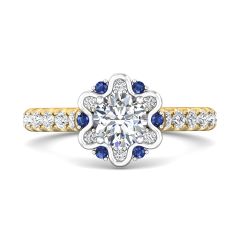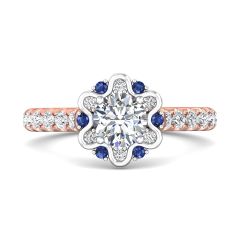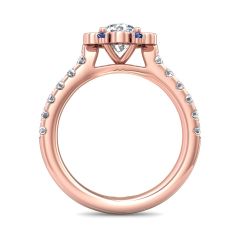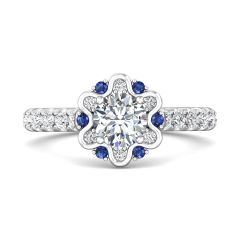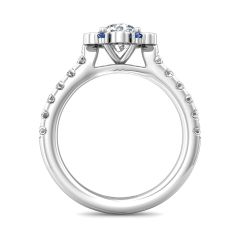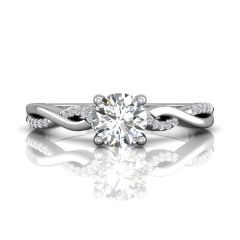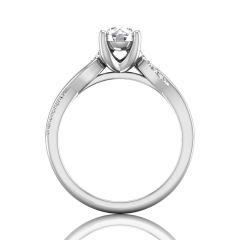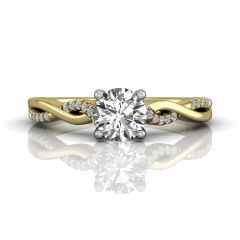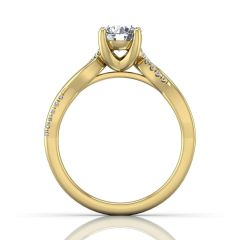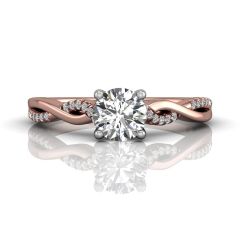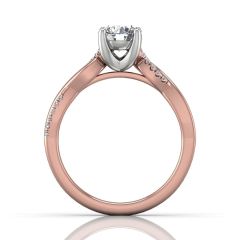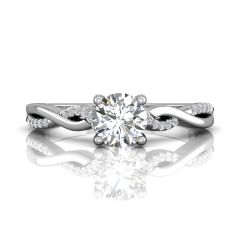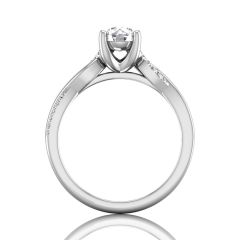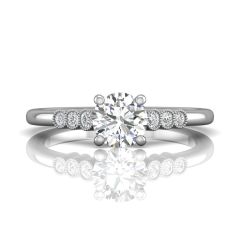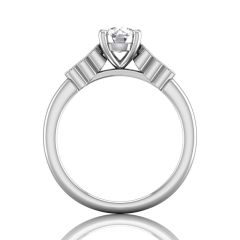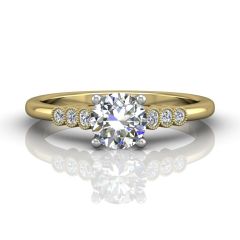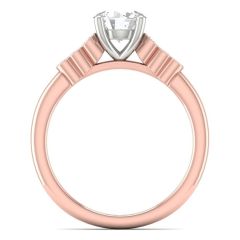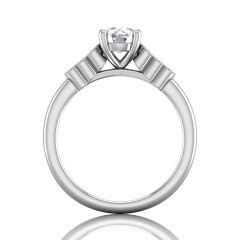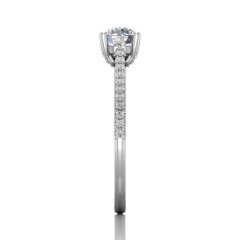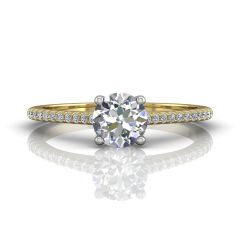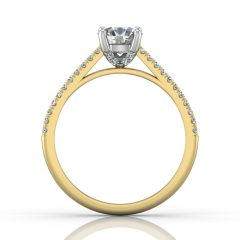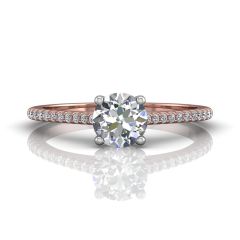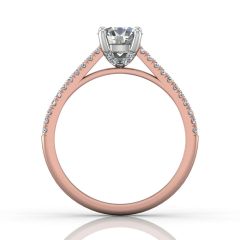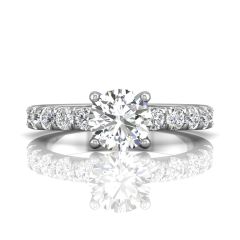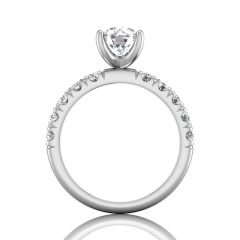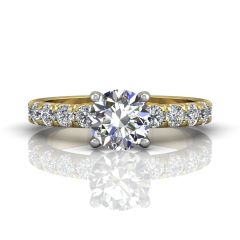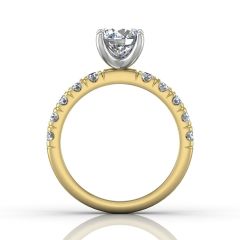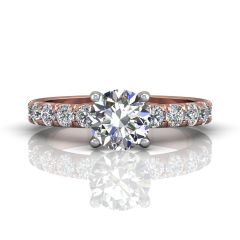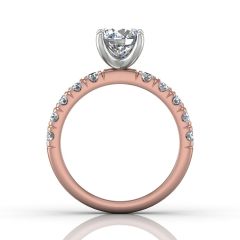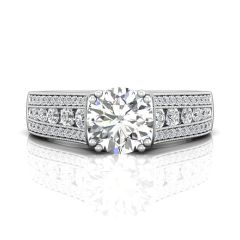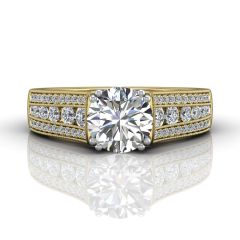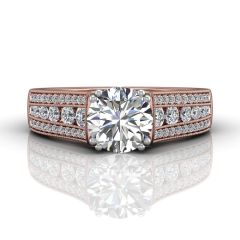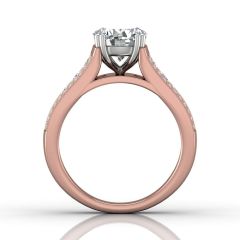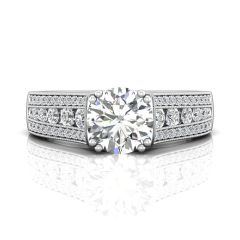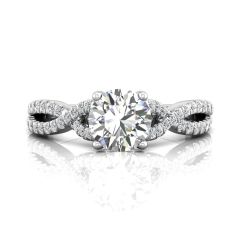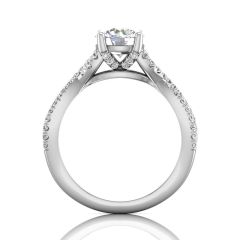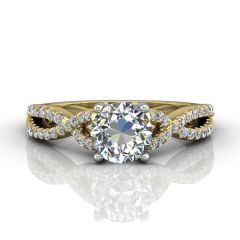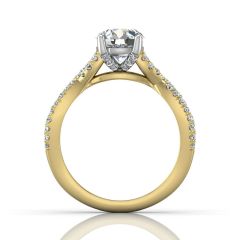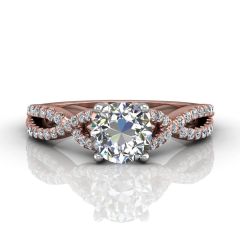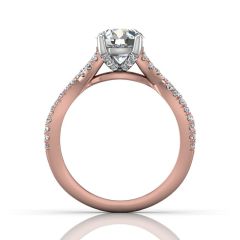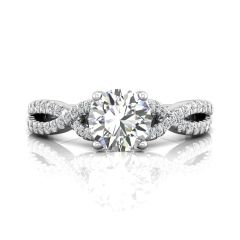Side Stone Engagement Rings
What is a Side Stone Engagement Ring?
A side stone engagement ring refers to an engagement ring featuring side stones on the band of the engagement ring and is a style of engagement ring. Side stones can also be referred to as accent stones. There are two main types of side stones for engagement rings; Pavé and Channel set side stones. Initially added to engagement rings in the 19th century, side stones are popular because of the shine and sparkle they add to your engagement ring.
Read More
What are the types of side stones for engagement rings?
There are two main types of side stones used for engagement rings: Channel set side stones are smaller diamonds or gemstones set into a channel on the band of the ring. This side stone setting places diamonds into a groove or channel where the metal on the band of the ring on each side keeps the smaller stones in place. Channel setting is a very secure setting for side stones and a great option for engagement rings
Pavé set side stones are smaller gemstones set into a band typically held in place by smaller prongs or beads, giving the appearance of stones closely set together in a paved aesthetic. Micro pavé, french pavé, u-cut pave, petite pavé and bright cut pave are the different types of pave settings. Pave side stones are the most popular option of side stones for engagement rings.
What to consider when buying a side stone engagement ring?
When buying a side stone engagement ring you should consider many different things, in the list below are some of the key things to consider:
- Side Stones
- Gemstone
- Metal
- Setting
Side Stone
When buying a side stone engagement ring, the sidestones are the most important consideration. You have two types of side stone settings as options for your side stones. Pavé side stones are one option, and they’re the most popular option for engagement rings. There are different types of pavé; Micro pavé, french pavé, u-cut pavé, petite pavé and bright cut pavé, which have different designs, and the best one will come down to your preference. Another option is channel side stones, they are another great option and provide less of a metal appearance then pave settings. Whether side stones are set half way, 2/3rds of the way or completely around the band of the engagement ring, it’s another element to consider when selecting side stones. Small round cut diamonds are the most popular cut of side stones, but there are other options like princess cuts, and tapered baguettes are other popular side stone shape options.
Gemstone
When buying a side stone engagement ring, the gemstones or diamonds are one of the most important considerations for your side stone style. What sort of gemstone you choose for your side stone style is important, whether you want a diamond, sapphire, ruby, or other gemstones. After choosing a stone, it’s important to look at 4 C’s; Cut, Colour, Clarity, and carat weight. The sizes of the diamonds and/or gemstones, whether it’s 0.5 carat, 0.75 carat,1 carat, 1.5 carat, or 2 carat side stone engagement Ring. Your budget is the key to helping make a decision for centre stone size and quality. Another consideration is the shapes of your centre stones, this is important and affects the overall design of your side stone style. Round, Oval, Princess, Asscher, Emerald and Pear cut centre stones are popular options for the side stone style.
Setting
There are 3 main setting options for side stone engagement rings: Prong, Bezel and tension settings. Prong settings are the most popular setting for side stone engagement rings, 4, 6, and 8 prong variations are the most common amount of prongs used for side stones. Tension settings are another option when choosing a setting for side stone, and are very unique, but only certain shapes can be set in a tension setting. Bezel settings also come in a full bezel, and half bezel alternatives, bezel options are the safest option, and are a great choice for those who are clumsy and prone to damaging their ring. The perfect setting for a side stone engagement ring comes down to your preference, and weighing up the benefits of the different settings.Metal
Platinum and gold are the two main metal choices for those interested in a side stone engagement ring. Platinum has its beautiful silver colour and is a very durable option for a side stone engagement ring. Gold comes in 9k, 14k, and 18k gold for engagement rings, along with white, yellow, and rose gold colours for side stone engagement rings. Consider the metal type you like along with the different colours, and the durability of the metal or its karat when choosing a metal for your side stone engagement ring.
Why should I Buy A Side Stone Engagement Ring?
Buying a side stone engagement ring comes with added shine, thanks to the extra stones contributing sparkle and brilliance. They also enhance the centre stone, creating a centre stone with a lot of brilliance and scintillation. Moreover, side stones provide customisation options, allowing for a unique and personalised design.However, there are drawbacks to consider. Side Stone Engagement Rings are generally more expensive than solitaire rings due to the additional stones and intricate settings. The increased shine might be too flashy for some, and the overall design can become more complex, potentially not appealing to those who prefer a simpler style.
What are the pros of buying a Side Stone engagement ring?
- Adds more shine: Side stones bring extra sparkle to the ring, making it more visually appealing and catching the eye with the increased brilliance. This added shine and brilliance makes side stones a popular option for those who like the extra sparkle of side stone diamonds.
- Enhances centre stone: The placement of side stones on the band of the ring doesn't just add visual appeal; it also works to enhance the beauty of the central stone. The brilliance of the smaller side stones shines and reflects onto the centre stone of the engagement ring, enhancing the centre stones brilliance, and provides the appearance of a larger diamond.
- Customisation of side stones: One of the key advantages of side stone rings lies in the customisation options. You can personalise your side stones by choosing the type, size, and arrangement of the side stones, allowing you to craft an engagement ring uniquely yours. This customisation ensures that your engagement ring is a true reflection of your personal style and preferences.
What are the cons of buying a Side Stone engagement ring?
- More Expensive than solitaires: While side stone engagement rings can be very appealing, the inclusion of extra stones and intricate settings often translates to a higher cost compared to rings without side stones. This increased expense can be a drawback for those with budget constraints.
- Side stones can be too shiny: The additional sparkle from side stones, although a pro for many, can be a con for those who prefer a simple or understated design. The addition of the side stones may be perceived as too flashy.
- Requires more maintenance: The additional stones and detailed settings create more surfaces for dirt accumulation. This results in more cleaning required as dirt accumulates quicker on the side stones as well.The delicate nature of side stones may make the ring more susceptible to wear and tear, and might require some more inspections to secure prongs and prevent stone loosening. Overall, it’s not a massive con but is a consideration when adding side stones to your engagement ring.
How much does a Side Stone engagement ring cost?
A side stone engagement ring at DG & Co. Jewellery costs between $1,195 - $5,085 for the style alone. When Choosing a diamond or gemstone centre stone this is what can really bring up the cost, especially when going for a large high quality Diamond or precious gemstone. The average side stone engagement ring with a centre stone is around $9,000 - $10,000.What are the most popular Side Stone engagement rings?
The best side stone engagement rings will ultimately be dependant on each person's preferences, but our most popular designs are below:
- Emerald Cut Hidden Halo Diamond Engagement Ring Four Prong Setting Pave Setting Side Stones In 18K White Gold
- 1.00CT 6 Claw GIA Certified Diamond Engagement Ring with Pave Setting Side Stone In 18K White Gold
- Round Cut 4 Claw Side Stone Engagement Ring with Channel Set Side Stones in 18K White
- Round Cut Diamond Engagement Ring with Grain Setting Side Stones in Platinum Engagement Ring
- Oval Cut Halo Style Diamond Engagement Ring Pave Setting Side Stones With 4 Claw Setting Centre Stone In 18k Yellow Gold
- Emerald Cut Four Claw Diamond Ring with grain set side stones
- Round Cut Split Shank Diamond Engagement Ring with a Twist Band and Pave Set Side Stones
- Round Cut Four Claws Side Stone Engagement Ring with Milgrain Set Side Stones in 18K Yellow
- Emerald Cut Four Prongs Diamond Ring with Channel Set Side Stones in 18K Yellow
- Emerald Cut 3 Stones Diamond Engagement Ring Tapered Baguette Side Stones in 18K Rose
What are the alternative styles to Side Stone engagement rings?
There are many alternative styles to a side stone engagement ring. Some of the most common alternative styles are halo, double halo, split shank, and three stone; they can all also feature side stones in their engagement rings.
What are engagement rings with no side stones called?
Engagement rings featuring no side stones are called solitaire rings. Solitaire engagement rings consist of a single solitaire diamond on a plain metal band with no side stones.
Frequently Asked Questions
Small diamonds or gemstones are set tightly together to form a glittering surface in the pavé and micro pavé setting styles. The size of the diamonds or jewels used is the fundamental distinction between the two: pavé settings normally employ somewhat bigger stones, whilst micro pavé settings utilise extremely small stones placed even closer together. Micro pavé settings offer a more understated and elegant appearance than pavé settings, which often have a more pronounced appearance.
A diamond or gemstone is set into the ring band in a continuous groove to create a channel set engagement ring. The metal of the band protects the stones, which are often placed flush with the ring's surface. Different kinds of diamonds or gemstones can be used to create channel set engagement rings, which can be styled in either a straight or curved design. They enhance the ring's style and are extremely sturdy.
Yes, you can have any shaped side stone that appeals to you. round, princess, oval, pear, and marquise stone shapes are the most popular side stone options. When selecting the shape of the side stones, take into account the ring's overall design, and the shape and colour of the centre stone in the engagement ring.
Personal taste should be the determining factor, when deciding the cut of the centre stone in a side stone engagement ring: Round, princess, oval, pear, and marquise cuts are common choices. When selecting the shape of the centre stone, take the ring's entire design and your preferences into account.
The most well-liked selections for side stones include rubies, sapphires, and emeralds. These jewels come in a variety of colours, and you can choose one to suit your preferences and style. The selection of side stones is a matter of taste.
An engagement ring can be customised in a multitude of ways in order to suit you and your style. The integration of an eternity band is a customisation that can be added to your engagement ring. However, we do recommend if this is something you're considering, to discuss this customisation and others with one of our jewellers.
Free Shipping
Lifetime
Guarantee
Complementary
Valuation
Conflict Free
Diamonds

30 Day Money Back
Guarantee
DG & Co. Guarantees
Free Shipping
Lifetime
Guarantee
Complementary
Valuation
Conflict Free
Diamonds

30 Day Money Back
Guarantee
Contact Us


